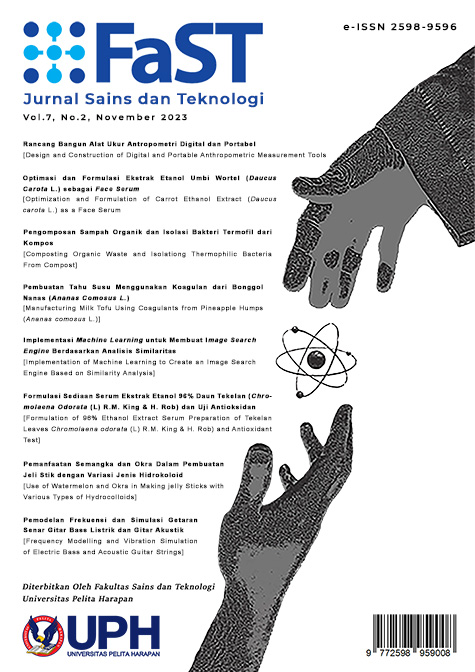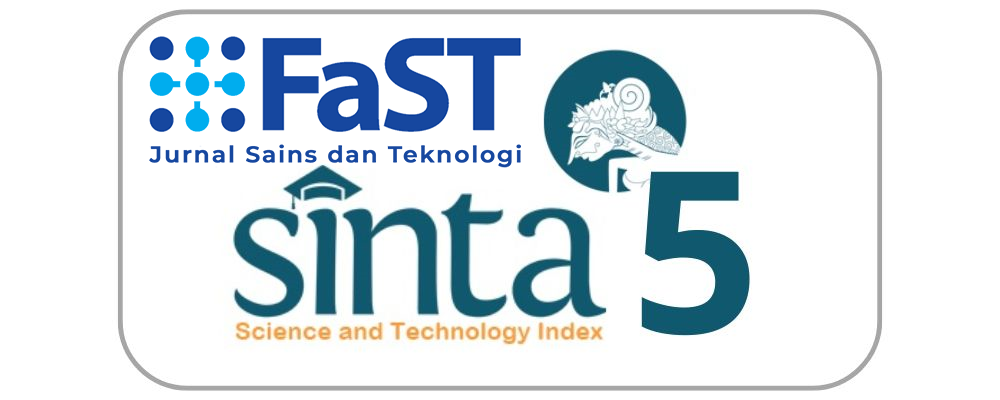FORMULASI SEDIAAN SERUM EKSTRAK ETANOL 96% DAUN TEKELAN (Chromolaena odorata (L) R.M. King & H. Rob) DAN UJI ANTIOKSIDAN [FORMULATION OF 96% ETHANOL EXTRACT SERUM PREPARATION OF TEKELAN LEAVES (Chromolaena odorata (L) R.M. King & H. Rob) AND ANTIOXIDANT TEST]
DOI:
https://doi.org/10.19166/jstfast.v7i2.6917Keywords:
antioxidant, tekelan leave, serumAbstract
Tekelan leaves are known to have antioxidant activity therefore they can be developed into cosmetic products. The objective of this study was to develop a serum formulation from tekelan leaves extract and antioxidant test. Tekelan leaves extract was prepared by maceration with 96% ethanol. The 96% ethanol extract of tekelan leaves extract was made into 3 formulations with a variety of emollient ingredients, namely squalene, dimethicone and almond oil. Evaluation carried out on serum preparations included organoleptic, homogeneity, pH, viscosity, specific gravity, adhesion and stability tests. The extract yield was 25.40%. Testing for phytochemical content showed that the extract contained alkaloids, flavanoids, phenols, tannins, saponins and steroids. Evaluation results of the three serum formulas meet physical quality test requirement such as organoleptic, homogenity, pH, specific weight and viscosity but did not meet the adhesion test requirements. In addition, all three serum formulas showed very weak antioxidant activity.
Bahasa Indonesia Abstract:
Daun tekelan diketahui mempunyai aktivitas antioksidan sehingga dapat dibuat menjadi sediaan kosmetik. Tujuan dari penelitian ini adalah untuk membuat formulasi sediaan serum dari daun tekelan dan pengujian aktivitas antioksidan serum. Ekstrak daun tekelan dibuat dengan maserasi menggunakan etanol 96%. Ekstrak etanol 96% daun tekelan dibuat menjadi 3 formulasi dengan variasi bahan emolien yaitu squalene, dimethicone dan almond oil. Evaluasi yang dilakukan terhadap sediaan serum meliputi uji organoleptik, homogenitas, pH, viskositas, bobot jenis, daya lekat dan stabilitas. Hasil ekstrak yang diperoleh sebanyak 25,40%. Pengujian kandungan fitokimia menunjukkan bahwa ekstrak mengandung alkaloid, flavanoid, fenol, tanin, saponin dan steroid. Hasil evaluasi ketiga formula sediaan serum memenuhi persyaratan uji mutu fisik yaitu organoleptik, homogenitas, pH, bobot jenis dan viskositas tetapi tidak memenuhi syarat uji daya lekat. Selain itu, ketiga sediaan serum menunjukkan aktivitas antioksidan yang sangat lemah.
References
Ariyanti, E. L., Handayani, R. P., & Yanto, E. S. (2020). Formulasi sediaan serum antioksidan dari ekstrak sari tomat (Solanum lycopersicum L) dan ekstrak kayu manis (Cinnamomum burmannii) sebagai perawatan kulit. Journal of Holistic and Health Sciences, 4(1), 50-57. https://doi.org/10.51873/jhhs.v4i1.80
Cahya, A., & Fitri, N. (2020). Formulasi dan uji antioksidan serum wajah berbasis minyak jintan hitam (Nigella sativa L.) menggunakan metode DPPH. Asian Journal of Innovation and Entrepreneurship, 5(3), 44-53.
Farsnworth, N. R. (1966). Biological dan phytochemical screening of plant. Journal of Pharmaceutical Sciences, 55(3), 225-276. https://doi.org/10.1002/jps.2600550302
Febrianti, D., Ariani, N., & Niah, R. (2021). Antioksidan daun kumpai mahung (Eupathorium inulifolium H.B&K). Jurnal Pharmascience, 8(1), 94-100. https://doi.org/10.20527/jps.v8i1.9108
Febrya, I. W. V. (2016). Penggunaan green cosmetic dalam mewujudkan perilaku kesadaran lingkungan. Jurnal Ilmu Lingkungan, 10(2), 199-203.
Handayany, G., Umar, I., & Ismail, I. (2018). Formulasi dan uji efektivitas antioksidan krim ekstrak etanol daun botto’-botto’ (Chromolaena Odorata L.) dengan metode DPPH. Jurnal Kesehatan,11(2),86-90. https://doi.org/10.24252/kesehatan.v11i2.5944
Harjanti, R., & Nilawati, A. (2020). Aktivitas antioksidan dan potensi tabir surya serum ekstrak terpurifikasi daun wangon (Olax psittacorum Willd Vahl.). Jurnal Farmasi Indonesia, 17(1), 18-28. http://dx.doi.org/10.31001/jfi.v17i1.779
Harborne, J. B. (1987). Metode fitokimia penuntun cara modern menganalisis tumbuhan. ITB Press.
Hikmah, F. N., Malahayati, S., & Nilawati, A., Nugraha, D. F. (2023). Formulasi dan evaluasi sediaan serum gel ekstrak bunga melati (Jasminum sambac L.). Journal of Pharmaceutical Care and Sciences, 3(2), 93-108. https://doi.org/10.33859/jpcs.v3i2.248
Ilmu gizi menjadi sangat mudah (2nd ed., L. Dwijayanthi. Trans.) (2011). Jakarta: EGC.
Phongpaichit, S., Nikom, J., Rungjindamai, N., Sakayaroj, J., Hutadilok-Towatana, N., Rukachaisirikul, V., & Kirtikara, K. (2007) Biological activities of extracts from endophytic fungi isolated from garcinia plants. FEMS Immunology & Medical Microbiology, 51(3), 517-525. https://doi.org/10.1111/j.1574-695x.2007.00331.x
Robinson, M. K., & Perkins, M.A. (2002). A Strategy for skin irritation testing. American Journal of Contact Dermatitis, 13(1), 21-29. https://doi.org/10.1053/ajcd.2002.30471
Saputra, A., Gani, A., Erlidawati. (2017). Uji aktivitas antioksidan daun gulma siam (Chromolaena Odorata L.) dengan metode 1,1-difenil-2 pikrilhidrazil. Jurnal IPA dan Pembelajaran IPA, 1(2), 131-142. https://doi.org/10.24815/jipi.v1i2.9687
Sartiah, M. B. (2015). Pengaruh penggunaan masker buah aprikot (Prunus armeniaca) kering terhadap kelembapan kulit wajah kering. Jurnal Tata Rias, 4(1), 24-30.
Siahaan, E., Pangkahila, W., & Wiraguna, A A. G. P. (2017). Krim ekstrak kulit delima merah (Punica granatum) menghambat peningkatan jumlah melanin sama efektifnya dengan krim hidrokuinon pada kulit marmut (Cavia porcellus) betina yang dipapar sinar uvb. Jurnal Biomedik, 9(1), 7-13. https://doi.org/10.35790/jbm.9.1.2017.15313
Tjahjani, N. P., Chairunnisa, A., & Helmiana, T. V. (2021). Penapisan kandungan fitokimia dan penetapan kadar total flavonoid ekstrak etanolik daun tekelan. Jurnal Farmasetis, 10(2), 113-122.
Downloads
Published
Issue
Section
License
“Authors who publish with this journal agree to the following terms:
1) Authors retain copyright and grant the journal right of first publication with the work simultaneously licensed under a Creative Commons Attribution License (CC-BY-SA 4.0) that allows others to share the work with an acknowledgement of the work's authorship and initial publication in this journal.
2) Authors are able to enter into separate, additional contractual arrangements for the non-exclusive distribution of the journal's published version of the work (e.g., post it to an institutional repository or publish it in a book), with an acknowledgement of its initial publication in this journal.
3) Authors are permitted and encouraged to post their work online (e.g., in institutional repositories or on their website). The final published PDF should be used and bibliographic details that credit the publication in this journal should be included.”



